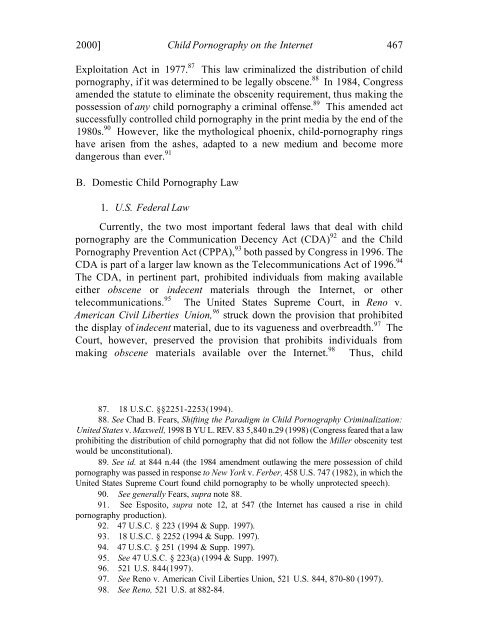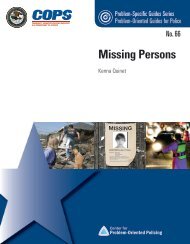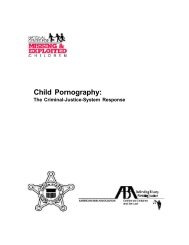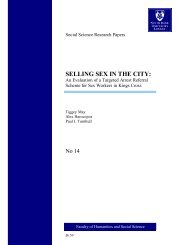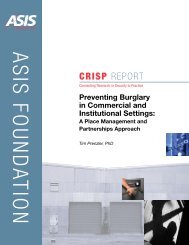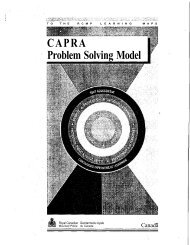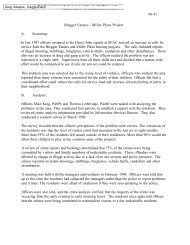uncovering and eliminating child pornography rings on the internet
uncovering and eliminating child pornography rings on the internet
uncovering and eliminating child pornography rings on the internet
You also want an ePaper? Increase the reach of your titles
YUMPU automatically turns print PDFs into web optimized ePapers that Google loves.
2000] Child Pornography <strong>on</strong> <strong>the</strong> Internet 467<br />
Exploitati<strong>on</strong> Act in 1977. 87 This law criminalized <strong>the</strong> distributi<strong>on</strong> of <str<strong>on</strong>g>child</str<strong>on</strong>g><br />
<str<strong>on</strong>g>pornography</str<strong>on</strong>g>, if it was determined to be legally obscene. 88 In 1984, C<strong>on</strong>gress<br />
amended <strong>the</strong> statute to eliminate <strong>the</strong> obscenity requirement, thus making <strong>the</strong><br />
possessi<strong>on</strong> of any <str<strong>on</strong>g>child</str<strong>on</strong>g> <str<strong>on</strong>g>pornography</str<strong>on</strong>g> a criminal offense. 89 This amended act<br />
successfully c<strong>on</strong>trolled <str<strong>on</strong>g>child</str<strong>on</strong>g> <str<strong>on</strong>g>pornography</str<strong>on</strong>g> in <strong>the</strong> print media by <strong>the</strong> end of <strong>the</strong><br />
1980s. 90 However, like <strong>the</strong> mythological phoenix, <str<strong>on</strong>g>child</str<strong>on</strong>g>-<str<strong>on</strong>g>pornography</str<strong>on</strong>g> <str<strong>on</strong>g>rings</str<strong>on</strong>g><br />
have arisen from <strong>the</strong> ashes, adapted to a new medium <str<strong>on</strong>g>and</str<strong>on</strong>g> become more<br />
dangerous than ever. 91<br />
B. Domestic Child Pornography Law<br />
1. U.S. Federal Law<br />
Currently, <strong>the</strong> two most important federal laws that deal with <str<strong>on</strong>g>child</str<strong>on</strong>g><br />
<str<strong>on</strong>g>pornography</str<strong>on</strong>g> are <strong>the</strong> Communicati<strong>on</strong> Decency Act (CDA) 92 <str<strong>on</strong>g>and</str<strong>on</strong>g> <strong>the</strong> Child<br />
Pornography Preventi<strong>on</strong> Act (CPPA), 93 both passed by C<strong>on</strong>gress in 1996. The<br />
CDA is part of a larger law known as <strong>the</strong> Telecommunicati<strong>on</strong>s Act of 1996. 94<br />
The CDA, in pertinent part, prohibited individuals from making available<br />
ei<strong>the</strong>r obscene or indecent materials through <strong>the</strong> Internet, or o<strong>the</strong>r<br />
telecommunicati<strong>on</strong>s. 95 The United States Supreme Court, in Reno v.<br />
American Civil Liberties Uni<strong>on</strong>, 96 struck down <strong>the</strong> provisi<strong>on</strong> that prohibited<br />
<strong>the</strong> display of indecent material, due to its vagueness <str<strong>on</strong>g>and</str<strong>on</strong>g> overbreadth. 97 The<br />
Court, however, preserved <strong>the</strong> provisi<strong>on</strong> that prohibits individuals from<br />
making obscene materials available over <strong>the</strong> Internet. 98 Thus, <str<strong>on</strong>g>child</str<strong>on</strong>g><br />
87. 18 U.S.C. §§2251-2253(1994).<br />
88. See Chad B. Fears, Shifting <strong>the</strong> Paradigm in Child Pornography Criminalizati<strong>on</strong>:<br />
United States v. Maxwell, 1998 B YU L. REV. 83 5,840 n.29 (1998) (C<strong>on</strong>gress feared that a law<br />
prohibiting <strong>the</strong> distributi<strong>on</strong> of <str<strong>on</strong>g>child</str<strong>on</strong>g> <str<strong>on</strong>g>pornography</str<strong>on</strong>g> that did not follow <strong>the</strong> Miller obscenity test<br />
would be unc<strong>on</strong>stituti<strong>on</strong>al).<br />
89. See id. at 844 n.44 (<strong>the</strong> 1984 amendment outlawing <strong>the</strong> mere possessi<strong>on</strong> of <str<strong>on</strong>g>child</str<strong>on</strong>g><br />
<str<strong>on</strong>g>pornography</str<strong>on</strong>g> was passed in resp<strong>on</strong>se to New York v. Ferber, 458 U.S. 747 (1982), in which <strong>the</strong><br />
United States Supreme Court found <str<strong>on</strong>g>child</str<strong>on</strong>g> <str<strong>on</strong>g>pornography</str<strong>on</strong>g> to be wholly unprotected speech).<br />
90. See generally Fears, supra note 88.<br />
91. See Esposito, supra note 12, at 547 (<strong>the</strong> Internet has caused a rise in <str<strong>on</strong>g>child</str<strong>on</strong>g><br />
<str<strong>on</strong>g>pornography</str<strong>on</strong>g> producti<strong>on</strong>).<br />
92. 47 U.S.C. § 223 (1994 & Supp. 1997).<br />
93. 18 U.S.C. § 2252 (1994 & Supp. 1997).<br />
94. 47 U.S.C. § 251 (1994 & Supp. 1997).<br />
95. See 47 U.S.C. § 223(a) (1994 & Supp. 1997).<br />
96. 521 U.S. 844(1997).<br />
97. See Reno v. American Civil Liberties Uni<strong>on</strong>, 521 U.S. 844, 870-80 (1997).<br />
98. See Reno, 521 U.S. at 882-84.


